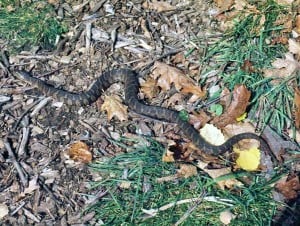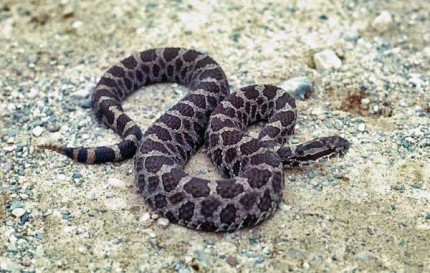
(Chelsea Update would like to thank Tom Hodgson and the Waterloo Natural History Association for the information and photos in this column.)
There is something about snakes that strikes fear into the hearts of many while fascinating others.
My youngest daughter thinks snakes are disgusting because they don’t have legs. “Animals should have legs,” she says.

Being without legs can have its advantages. It may allow a hungry snake to follow a mouse right into its tunnel. Then after eating the occupant, lay claim to the tunnel for its own use. Most snakes cannot dig holes on their own. They must depend on those dug by others. So none of the holes found in the woods can actually be considered “snake holes.”
Snakes and other reptiles are considered cold-blooded because they cannot generate enough metabolic heat to maintain a constant body temperature. On cool, sunny days, snakes will lie in the sun to warm up. If they are too cold they become slow and sluggish, which makes them vulnerable to predators and makes it difficult for them to capture prey.

Raising their body temperature through sunning also helps digest their food. Digestion involves complex chemical reactions. And those of us who had high school chemistry may remember that chemical reactions occur more rapidly when heat is added.
The weather has been cool of late, so those of us enjoying the outdoors this Memorial Day weekend may encounter a snake sunning itself along a sunny trail or shore line.
Unfortunately, we may not notice them until they move, which can make for a startling experience. Not to worry. None of Michigan’s native snakes are large enough to consider humans as prey and usually do their best to avoid us.
There are 18 snake species that call Michigan home. Only one, the Eastern Massasauga Rattlesnake is venomous. Fortunately, this shy snake is seldom seen. Of all the above, the two one is most likely to encounter this weekend are the Eastern Garter snake and the Northern Water Snake.

Eastern Garter Snake
The Eastern Garter Snake is often called the “garden snake” as it sometimes can be found urban lawns and gardens. It is a small to medium sized snake (18 to 54 inches) with three stripes down the length of its body. These stripes may vary in color from yellow, green or blue depending on the individual.
The dark background color may vary also from black, brown, to olive green. This snake gets its name from the light marks imbedded in the dark background that give it an elastic appearance like a lady’s garter.
Garter snakes eat frogs, toads, earthworms and insects. Some individuals are more aggressive than others and may bite if picked up. They may also smear an unpleasant smelling secretion from their anal glands on the captor’s hand.

Northern Water Snake
The Northern Water Snake is a medium sized to large (24 to 55 inches), heavy bodied snake. It is the snake one is most likely to encounter near water. Most have a pattern including dark brown or black bands or blotches against a lighter brown or gray background. The pattern fades on large individuals who may appear more uniformly black or dark brown.
Northern Water Snakes feed on frogs and small fish. They are often mistakenly called “water moccasins.” Water moccasins are venomous snakes of the southern states and are not found in Michigan.
Water snakes will bite if picked up, and will also smear large amounts of anal secretions or feces on their captors. If you don’t want this unpleasant experience, don’t pick them up. Remember, if you leave snakes alone, they will leave you alone.
Have a great weekend.




















I always enjoy your posts here. I do regularly see garter snakes. One time saw one in a flower bed very slowly eating a toad. Sigh… but the snake has to eat too! One time saw a milk snake in my vegetable garden. I took a photo and sent to more expert folks to identify. It was a lovely snake. Wish I would see one again.
Do you have any photos of baby garter snakes, water snakes, and Massasauga rattlesnakes? Last fall I came across 3 small snakes under a stepping rock and their pattern looked more like the Massasauga, but it seemed unlikely to find them there. I also wasn’t sure if you would see a rattle on the baby. And I didn’t know how similar the baby garter’s pattern could look? Is there any where I could send/share a photo and have someone tell me what it is? Thanks!
Don’t have pictures of the baby snakes you mentioned. Garter snakes look the same throughout life. Young blue racers have a pattern and don’t develop the blue-gray color until they get older.
Milk snakes have a bold pattern that could be confused with a rattle snake. If you google images of these species this may help you.